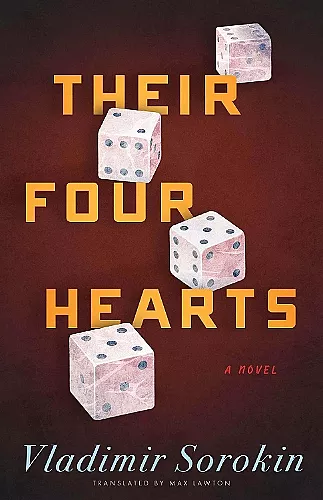Their Four Hearts
Vladimir Sorokin author Max Lawton translator Gregory Klassen illustrator
Format:Paperback
Publisher:Dalkey Archive Press
Published:9th Jun '22
Should be back in stock very soon

Serial rights targeting The New Yorker, Harper’s, Paris Review, n+1 Print and digital publicity targeting NPR, The Atlantic,Bookforum, Los Angeles Times, New York Review of Books, London Review of Books, New York Times, Washington Post, The Nation, Words Without Borders Promotion and outreach to university literature and Russian studies departments, Harriman Institute at Columbia University Review copies sent targeting all major print and digital literary media outlets, reviewers, and booksellers; additional copies available upon request Promotion on publisher’s website and social media; promotion via e-newsletters to booksellers, reviewers
The novel that reportedly caused a walkout upon publication, this grotesque, absurdist work by Russia's de Sade follows four individuals set upon a common goal of destruction and violence.In many respects, Their Four Hearts is a book of endings and final things. Vladimir Sorokin wrote it in the year the Soviet Union collapsed and then didn’t write fiction for ten years after completing it––his next book being the infamous Blue Lard, which he wrote in 1998. Without exaggerating too much, one might call it the last book of the Russian twentieth century and Blue Lard the first book of the Russian twenty-first century. It is a novel about the failure of the Soviet Union, about its metaphysical designs, and about the violence it produced, but presented as God might see it or Bataille might write it. Their Four Hearts follows the violent and nonsensical missions carried out by a group of four characters who represent Socialist Realist archetypes: Seryozha, a naive and optimistic young boy; Olga, a dedicated female athlete; Shtaube, a wise old man; and Rebrov, a factory worker and a Stakhanovite embodying Soviet manhood. However, the degradation inflicted upon them is hardly a Socialist Realist trope. Are the acts of violence they carry out a more realistic vision of what the Soviet Union forced its “heroes” to live out? A corporealization and desacralization of self-sacrificing acts of Soviet heroism? How the Soviet Union truly looked if you were to strip away the ideological infrastructure? As we see in the long monologues Shtaube performs for his companions––some of which are scatological nonsense and some of which are accurate reproductions of Soviet language––Sorokin is interested in burrowing down to the libidinal impulses that fuel a totalitarian system and forcing the reader to take part in them in a way that isn’t entirely devoid of aesthetic pleasure. As presented alongside Greg Klassen’s brilliant charcoal illustrations, which have been compared to the work of Bruno Schulz by Alexander Genis and the work of Ralph Steadman as filtered through Francis Bacon by several gallerists, this angular work of fiction becomes a scatological storybook-world that the reader is dared to immerse themselves in.
Finalist, Russian Booker, 1992 "Generously spiced with filthy and vulgar terms... an absurdist work, a veritable encyclopedia of... the bizarre." —Liza Rozovsky "Sorokin’s sudden exposure is long overdue as he is probably both the most acclaimed and the most controversial author in Russia today, hailed by critics as a ‘living classic’ even as his subject matter takes the tradition of Russian grotesque into areas Gogol or even the Stalin-era absurdist Daniil Kharms never dared venture." —Daniel Kalder, Publishing Perspectives
ISBN: 9781628973969
Dimensions: unknown
Weight: unknown
204 pages